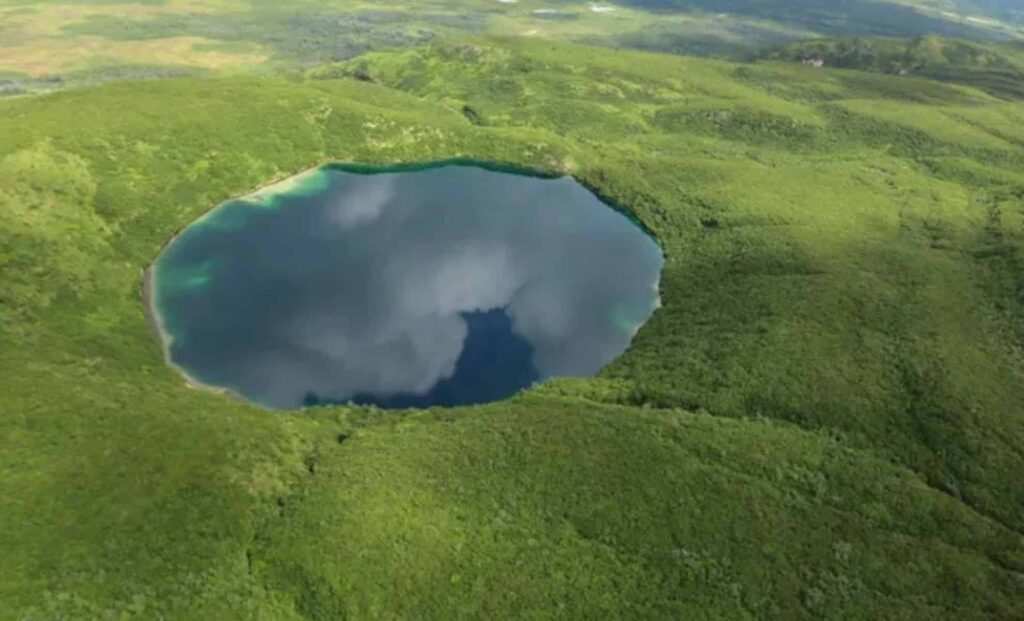The Mystery of Savonoski Crater
Deep within Alaska’s Katmai National Park lies an intriguing and puzzling geological formation known as Savonoski Crater. This crater is remarkably round, measuring 1,600 feet in diameter, and has mystified scientists for many years. Despite its striking appearance, which suggests it was created by a massive impact or explosion, researchers are still unable to pinpoint its exact origin.
The Enigmatic Crater
First Impressions
At first glance, Savonoski Crater seems like the site of a meteorite impact. Its smooth circular shape and steep walls resemble other impact craters found around the world. However, there is a significant problem: no fragments of a meteorite or any debris from space have been discovered in the area. This has led to various hypotheses regarding its formation.
The Volcanic Theory
Another theory suggests that Savonoski Crater may have formed as a volcanic maar. A maar is a type of crater created when rising magma encounters underground water, resulting in a steam-driven explosion that blasts out a concave depression. While this explanation is compelling, there are no other known volcanic features in the vicinity to support the idea that a volcanic event could have created this crater.
The Ongoing Search for Answers
Exploration Efforts
Scientists have known about Savonoski Crater for decades, and attempts to study it date back to the 1960s and 1970s. However, these investigations did not yield sufficient evidence to confirm how the crater formed. The last thorough examination of the crater’s origins was conducted in 1978, but it failed to provide a definitive answer. Once geologists suspected it was a meteor impact based on its size, careful study revealed no meteoritic materials, shocked rocks, or signs of an explosive event—elements typically found at impact sites.
With the meteorite theory dismissed, scientists turned their attention to the volcanic maar hypothesis. They drew upon the example of the Ukinrek Maars, located about 100 miles away, which were created during a volcanic eruption in 1977. However, Savonoski does not show signs of a magma source or volcanic activity, further complicating our understanding of its formation.
Glacial Impacts on the Crater’s History
One of the major hurdles in discovering the truth about Savonoski Crater is that much of its geological history may have been erased by glaciers. Research indicates that the region experienced significant glaciation between 23,000 and 14,700 years ago. During this time, massive ice sheets could have covered the area, potentially obscuring any evidence of either a meteorite impact or a volcanic eruption.
The ice could have smoothed over the land and erased important geological markings that usually identify such events. Some scientists suggest that clues about the crater’s origins might still be found buried beneath the surface. Drilling into the center of the crater could reveal various rock layers that might provide invaluable information.
A Geological Enigma
Despite numerous theories and decades of speculation, Savonoski Crater remains an unsolved mystery. Many scientists agree that it was likely formed by either a meteorite impact or a volcanic event, but the absence of solid geological evidence keeps the mystery alive. Additionally, the possibility of other unknown geological processes contributing to its formation cannot be entirely ruled out.
In the future, advanced techniques such as deep-core drilling or high-tech imaging could be employed to learn more about Savonoski Crater and potentially unlock the secrets it holds. Until that time, this perfectly round crater will continue to be one of Earth’s most captivating geological wonders, a reminder that there are still many secrets left to uncover about our planet.
